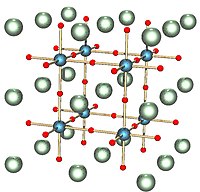
Photo from wikipedia
Surface passivation treatment is a widely used strategy to resolve trap‐mediated nonradiative recombination toward high‐efficiency metal‐halide perovskite photovoltaics. However, a lack of passivation with mixture treatment has been investigated, as… Click to show full abstract
Surface passivation treatment is a widely used strategy to resolve trap‐mediated nonradiative recombination toward high‐efficiency metal‐halide perovskite photovoltaics. However, a lack of passivation with mixture treatment has been investigated, as well as an in‐depth understanding of its passivation mechanism. Here, a systematic study on a mixed‐salt passivation strategy of formamidinium bromide (FABr) coupled with different F‐substituted alkyl lengths of ammonium iodide is demonstrated. It is obtained better device performance with decreasing chain length of the F‐substituted alkyl ammonium iodide in the presence of FABr. Moreover, they unraveled a synergistic passivation mechanism of the mixed‐salt treatment through surface reconstruction engineering, where FABr dominates the reformation of the perovskite surface via reacting with the excess PbI2. Meanwhile, ammonium iodide passivates the perovskite grain boundaries both on the surface and top perovskite bulk through penetration. This synergistic passivation engineer results in a high‐quality perovskite surface with fewer defects and suppressed ion migration, leading to a champion efficiency of 23.5% with mixed‐salt treatment. In addition, the introduction of the moisture resisted F‐substituted groups presents a more hydrophobic perovskite surface, thus enabling the decorated devices with excellent long‐term stability under a high humid atmosphere as well as operational conditions.
Journal Title: Advanced Functional Materials
Year Published: 2021
Link to full text (if available)
Share on Social Media: Sign Up to like & get
recommendations!